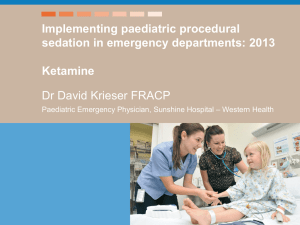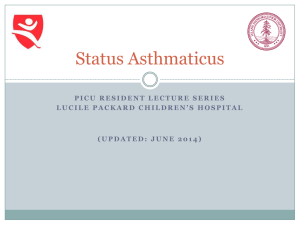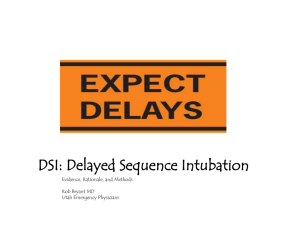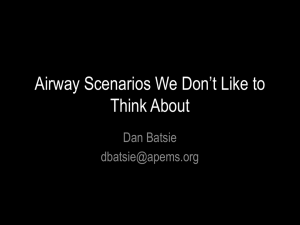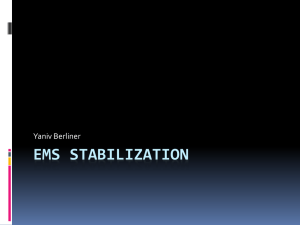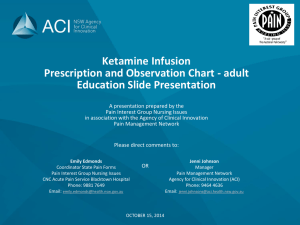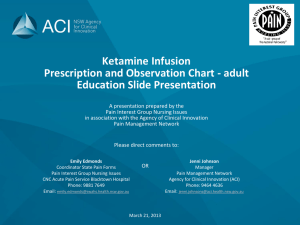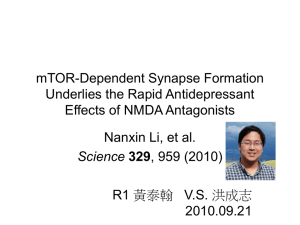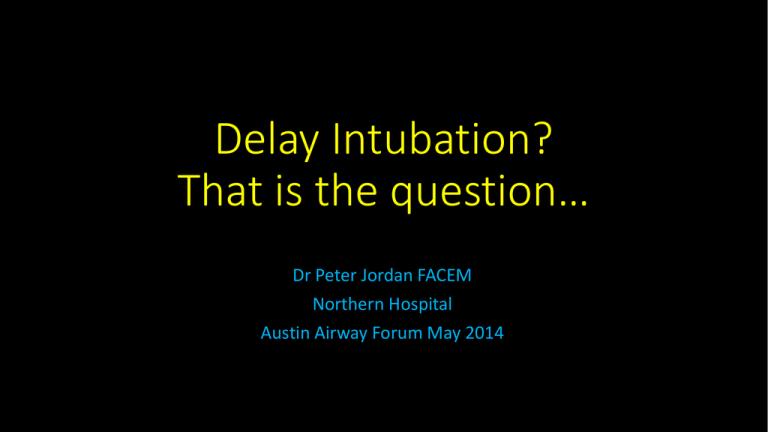
Delay Intubation?
That is the question…
Dr Peter Jordan FACEM
Northern Hospital
Austin Airway Forum May 2014
• 3 Cases
• Background – ED Airway Management
• Preoxygenation
• Delayed Sequence Intubation
• NIV
• Ketamine
• How to Make it Happen
• Case Conclusions
• Questions
Case 1
Confused and uncooperative 36YO male arrives via MAS at 0300
Probable alcohol +/- benzodiazepines +/- TCA
Noisy resps, SaO2 89% on High Flow NRBM
What are you going to do?
Case 2
Sunday PM
Obese (>120kg) 48 man
COPD/ Sleep apnoea/ HT
Decreased Mental status and marked hypoxia.
Sa02 68%, HR 140
Now what?
Case 3
37YO female – Obvious respiratory distress – unrecordable SaO2,
?cyanosed, Silent chest,
Uncooperative – Keeps removing Nebuliser mask and stepping off
trolley.
History of Severe Asthma - Multiple ICU interventions
So you wanna have a crack at intubation?
STEM.org.au
Consider Base Jumping…
BASE jumping is the most dangerous of the extreme sports. It is about
forty times more dangerous than plain old parachute jumping
The mortality from BASE jumping is around 0.04%.
But its not me on the end of the blue cigar..
• Difficult laryngoscopy occurred in 24%
• First pass success occurred in 83.4%
• Difficult intubation occurred in 3.4%
• Complications occurred in 29.0%
• Desaturation in 15.7%
• Periarrest Cardiac arrest occurred in 2.2% (no deaths)
Prospective observational study of the practice of endotracheal intubation in the emergency department of a tertiary hospital in Sydney,
Australia Fogg T et al EMA, 2012
Any other party poopers?
• NAP4 (UK)
• Death rate
• ED 0.8%
• ICU 3%
• “Difficult” approx. 10%
• Intubation in ED is 20 times more likely to kill you (as a patient) than
base jumping…
And the Problem is??
But these patients are pretty sick right?
When ALS succeeds, we convert a dead
patient into a live one
When RSI goes wrong we convert a live
patient into a dead one
What goes wrong?
• Hypotension most common adverse event (up to 45%)
But..
“Hypoxia was the most common primary contributor to death”
• Patient factors 23%
• Judgement 10%
• Education/ Training 7%
• Other – communication/ task failure
http://bja.oxfordjournals.org/content/106/5/632.full.pdf+html
So….what can I do to avoid this?
Prepare your team
Anticipate Difficult Physiology
Anticipate Difficult Intubation (consider awake intubation)
Prepare equipment and drugs
Optimise patient before Intubation
Become excellent at Intubating and cricothyrotomy
Preoxygenation
• Process of administering oxygen to a patient prior to intubation, so as
to extend ‘the safe apnea time’
• Oxygen consumption during apnea is approximately 250 mL/minute
(3 mL/kg per minute) in a healthy patient
• in critically ill patients desaturation may occur immediately despite
preoxygenation
Preoxygenation Goals
• Achieve SaO2 = 100%
• Denitrogenate the lungs
• Simply breathing 100% oxygen can increase O2 store in lungs from
450ml to 3000ml
• Oxygenate the blood (less significant)
• Maximise FRC
Optimizing Preoxygenation
• Position
• Nasal cannula O2 at 4-15L/min (as high as tolerated)
• NRBM at max flow if SaO2 >95%
Or NIV if SaO2 <95%, hypercapneic or obese
• Continue >3 minutes once SaO2 >95%
• DSI = procedural sedation, where
the procedure is preoxygenation
• The patient cannot tolerate
preoxygenation (or other preintubation procedures) due to
delirium and/ or agitation
• Facilitates correction of hypoxia
before paralysis
• Sedative (Ketamine) preserves
airway reflexes and respiratory drive
and has minimal effect on
haemodynamics
• Does not always involve NIV
Agitated and uncooperative - requires intubation..
Integrated approach to intubation
Administer induction agent, ideally ketamine 1-1.5 mg/kg
Place non-rebreather mask and nasal cannula at 15 L/min each
if SaO2 <95% then commence NIV – minimum 3 minutes or until SaO2>95% >3mins
Administer neuromuscular blocker
Perform Jaw thrust
Continue Oxygenating via nasal prongs (max flow) +/- continued CPAP 45seconds
Intubate patient
Is there any evidence?
Weingart SD. Preoxygenation, reoxygenation, and delayed
sequence intubation in the emergency department. J Emerg Med.
2011 Jun;40(6):661-7. Epub 2010 Apr 8. Review. PubMed
PMID: 20378297. [Free fulltext]
Weingart SD, Levitan RM. Preoxygenation and prevention of
desaturation during emergency airway management. Ann Emerg
Med. 2012 Mar;59(3):165-75.e1. Epub 2011 Nov 3. Review.
PubMed PMID: 22050948. [Free fulltext]
Other opportunities?
• Better preparation
•
•
•
•
•
•
•
•
•
•
•
Self
Team
Environment
patient
NGT insertion
IV access
Vasopressors/ Inotropes
IV Fluids
Bronchodilation
Observation/ Monitoring
Buys Time - ”Double Set-up?”
What if the patient improves?
• Great!!
• But beware…
• NNT = 4 (avoiding intubation)
• Failed NIV worsens outcomes
• If in doubt – Plan A is best
Timing of Noninvasive Ventilation Failure - Causes, Risk Factors, and Potential Remedies. Ezgi Ozyilmaz, Aylin
Ozsancak Ugurlu, Stefano Nava BMC Pulm Med. 2014;14(19)
What about Ketamine?
• Analgesic dose (0.1-0.3 mg/kg) – patient safely analgised – generally
inadequate for DSI
• Recreational dose (0.2-0.5 mg/kg) – patient ‘high’ he’s happy but you’re
not
• Partially (intermittently) dissociated dose (0.4-0.8 mg/kg) – patient ‘pear
shaped’….he’s unhappy..uncooperative = you’re unhappy
• Dissociative dose (>0.7 mg/kg) - both happy and patient fully
cooperative!!
Ketamine sounds is a wonder drug..
Potentially significant Adverse Effects..
• Laryngospasm – mostly in children (0.4%)
• Hypersalivation (~30%)
• Emesis (~5-15% - but almost always during emergence)
• Transient respiratory depression (usually in the first 2-3 minutes following a
large, rapidly administered IV dose)
• Transient mild increase in heart rate and blood pressure
Contraindications?
Absolute
• <3 months of age
• Psychosis, (even if currently stable and controlled with medications)
Relative
• Age of 3-12 months
• History of airway instability, tracheal surgery, or tracheal stenosis
• Unstable cardiovascular disease, including angina, heart failure, or
uncontrolled hypertension
• Acute Globe Injury and Glaucoma
Green SM, Roback MG, Kennedy RM, Krauss B. Clinical Practice Guideline for Emergency Department Ketamine Dissociative Sedation: 2011 Update. Annals of
emergency medicine. 2011 – in press. PMID: 21256625
Ketamine Alternatives
• Dexmedetomidine
• Fentanyl/ Remifenatanyl/ Alfentanyl
• Droperidol
• Combinations
NIV - Contraindications
• Pneumothorax
• Trauma
• AMI
• Severe acidosis
• Pre arrest
• Resource Issues
NIV - What can go wrong?
• Excessive secretions
• Mask leaks
• Pneumothorax
• Vomiting/ aspiration
• Patient-ventilator asynchrony
What if this happens?
• physiotherapeutic techniques
• judicious use of oral/ oro-pharyngeal suction
• Brief PPV
• changing ventilator settings – FiO2 (usually up) and pressures (up or
down..Max 15cm EPAP)
• Sedation/ More sedation
• Proceed to intubation
Other ideas?
emupdates.com
So should I use DSI or not?
Yes..in carefully selected situations…
• Improves Airway assessment and planning includes oxygenation
status and predictors of difficult preoxygenation as well as “difficult
airway”
• Shared Mental Model
• Facilitates use of other adjuncts
• Communicates expectation of Intubation – preparedness
• Methodical
Challenges/ Pitfalls:
•
•
•
•
•
•
•
•
Cognitive Barriers
Evidence – Local validation
Protocols and guidelines
Patient selection
Ketamine – understand and become familiar (whole team)
Training (multidisciplinary)
Teamwork Anticipate complications
Very Close observation and monitoring
Making it Happen
• Politics – gain approval/ agreement
• Train with your team
• Crisis Resource Management
• Debrief/ Discuss/ Audit/ Report
• airwayregistry.org.au
Case Conclusions
1. Confused 36yo M ..Intoxicated
Polypharmacy OD + probable aspiration
2. Obese (>120kg) 48 man
Decreased Mental status and marked hypoxia.
3. 37YO female
Cyanotic agitated asthmatic
Thanks………….Questions?
Sources:
emcrit.org
prehospitalmed.com (PHARM)
STEM.org.au
lifeinthefastlane.com
emupdates.com
Original Research and Reviews
(see following slides)
references
Prospective observational study of the practice of endotracheal intubation in the emergency department of a tertiary hospital in
Sydney, Australia Fogg T et al EMA, 2012
Ballard C, Fosse et al NIV improves preoxygenation before intubation of hypoxic patients. Am J Resp Care. 2006;174:171-7
Delay J et al, The effectiveness of Non Invasive Positive Pressure Ventilation to enhance oxygenation in morbidly obese patients. An
RCT. Anaesth Anal: 2008: 5
Green SM, Roback MG, Kennedy RM, Krauss B. Clinical Practice Guideline for Emergency Department Ketamine Dissociative Sedation:
2011 Update. Annals of emergency medicine. 2011 – in press. PMID: 21256625
Green SM, Cote CJ. Ketamine and neurotoxicity: clinical and implications for emergency medicine. Ann Emerg Med. 2009;54:181-190
references
Green SM, Li J. Ketamine in adults: what emergency physicians need to know about patient selection and emergence reactions
[editorial]. Acad Emerg Med. 2000;7:278-281
Mayberg TS, Lam AM, Matta BF, et al. Ketamine does not increase cerebral blood flow velocity or intracranial pressure during
isoflurane/nitrous oxide anesthesia in patients undergoing craniotomy. Anesth Analg. 1995;81:84-89.
Bar-Joseph G, Guilburd Y, Tamir A, et al. Effectiveness of ketamine in decreasing intracranial pressure in children with intracranial
hypertension. J Neurosurg Pediatr. 2009;4:40-46.
Bourgoin A, Albanese J, Wereszczynski N, et al. Safety of sedation with ketamine in severe head injury patients: comparison with
sufentanil. Crit Care Med. 2003;31:711-717.
985-1028.
Major complications of airway management in the UK: results of the Fourth National Audit Project of the Royal College of
Anaesthetists and the Difficult Airway Society. Part 2: intensive care and emergency departments† T. M. Cook,N. Woodall, J. Harper, J.
Benger, Br. J. Anaesth. (2011) 106 (5)
references
Vardy JM, Dignon N, Mukherjee N, et al. Audit of the safety and effectiveness of ketamine for procedural sedation in the emergency
department. Emerg Med J. 2008;25:579-582
Takeshita H, Okuda Y, Sari A. The effects of ketamine on cerebral circulation and metabolism in man. Anesthesiology. 1972;36:69-75
Timing of Noninvasive Ventilation Failure - Causes, Risk Factors, and Potential Remedies. Ezgi Ozyilmaz, Aylin Ozsancak Ugurlu,
Stefano Nava
BMC Pulm Med. 2014;14(19)
Strayer RJ, Nelson LS. Adverse events associated with ketamine for procedural sedation in adults. Am J Emerg Med. 2008;26:
Himmelseher S, Durieux ME. Revising a dogma: ketamine for patients with neurological injury? Anesth Analg. 2005;101:524-534.


